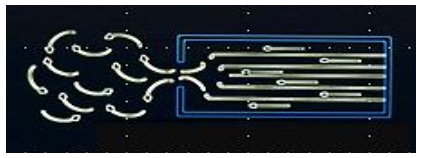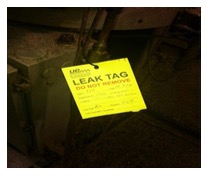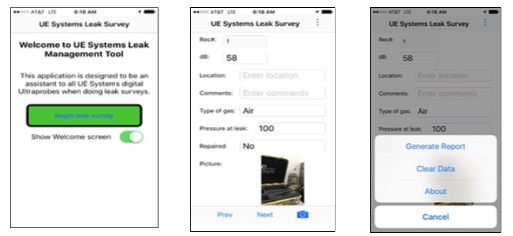Adrian Messer
CMRP
Manager of US Operations
UE Systems, Inc.
Ph: 864-224-4517 www.uesystems.comAbstract
 Contrary to what some might think, compressed air is not free. In fact, because of what it takes to produce it compared to what is generated, it is often considered the most expensive utility in a typical manufacturing facility. To further add to the problem, the US Department of Energy notes that more than 50% of all compressed air systems have energy efficiency problems. Air Compressor experts have also estimated that as much as 30% of the compressed air generated is lost via leaks in the compressed air system.
Contrary to what some might think, compressed air is not free. In fact, because of what it takes to produce it compared to what is generated, it is often considered the most expensive utility in a typical manufacturing facility. To further add to the problem, the US Department of Energy notes that more than 50% of all compressed air systems have energy efficiency problems. Air Compressor experts have also estimated that as much as 30% of the compressed air generated is lost via leaks in the compressed air system.
Compressed air and gas leak detection with ultrasound remains the most widely used application for this technology. By locating compressed air/gas leaks with ultrasound and then making the necessary repairs, ultrasound technology is a great application that can have tremendous payback in the dollars lost due to compressed air and compressed gas leaks. Recent advancements in compressed air leak detection and reporting allow for the quantification of the dollars lost and the CFM loss from compressed air leaks.
This presentation will discuss the use of ultrasound technology for planning and performing an effective ultrasonic compressed air leak survey that focuses on the evaluation, detection, identification, tracking, repair, verification, and reevaluation processes centered around a compressed air leak detection program. By implementing these steps, a typical manufacturing plant could reduce its energy waste by roughly 10 to 20 percent.
Introduction
Often times, when a compressed air system struggles to meet the current demands on the system, spare compressors are rented and used as back-ups or time and effort is placed in installing an additional compressor to the existing system. Both strategies are expensive, and depending on the size of the compressors needed, could mean hundreds of thousands of dollars and mean long-term returns.
Since compressed air systems inherently have leaks, regardless of piping, use, and design, implementing a compressed air leak management program can be an economical and effective way to improve the efficiency of any compressed air system.
Having a compressed air leak management program in place that is designed to identify and repair compressed air leaks before they become a large problem, can save time, money, and energy. Proper planning and creating a sense of awareness by educating employees on how costly compressed air leaks can be is integral to the success of any compressed air leak management program.
For airborne ultrasound, compressed air & compressed gas leak detection remains the most widely used application for this technology. By locating compressed air and gas leaks with ultrasound, and then making the necessary repairs, ultrasound technology is a tool that can have tremendous payback in the dollars lost due to compressed air and compressed gas leaks. Recent advancements in compressed air leak detection and reporting allow for the quantification of the dollars lost and the CFM loss from these compressed air leaks. An effective ultrasonic compressed air leak survey will focus on seven key factors: Evaluation, Detection, Identification, Tracking, Repair, Verification, and Re-Evaluation. By implementing these steps, a typical manufacturing plant could reduce its energy waste by roughly 10 to 20 percent. As an example, a 1/8” leak, at 100psi compressed air, at .22 cents per kilowatt hour, has an annual cost of $2,981.
Airborne Ultrasound – How Does It Work?
There are three generic forms of ultrasound technology: Pulse/Echo, Power, and Airborne/Structure-borne. Pulse/Echo is the most recognized form of ultrasound, as this is the medical form of ultrasound. Power ultrasound, as in an ultrasonic cleaner, is where high frequency sound waves are emitted. These high frequency sound waves have energy, and these sound waves clean parts and various materials. The form of ultrasound technology that is used for compressed air leak detection is airborne ultrasound. Airborne ultrasound is defined as high-frequency sound waves that are above the range of normal human hearing. Humans are able to receive sound within a frequency range of 20 Hertz (Hz) to 20 kilohertz (kHz) with the upper threshold of normal human hearing between 16kHz to 17kHz. The ultrasonic range begins at 20kHz. Most ultrasound instruments are capable of receiving or sensing these high frequency ultrasound sound waves within a frequency range of 20kHz to 100kHz. For ultrasonic leak detection, an ultrasound instrument that has frequency tuning capability is recommended, and the suggested frequency setting is 40kHz. For ultrasound instruments that are on a fixed frequency, or where frequency tuning is not a feature, the frequency setting that the instrument is fixed at is usually 38kHz.
There are different sources of high frequency sound that these ultrasound instruments detect. For compressed air and compressed gas leak detection, the source of the ultrasound is turbulence.

site, producing recognizable turbulent flow on the atmospheric side
Turbulence is created when a compressed gas inside of a pipe or vessel exits to low pressure or atmosphere through a tiny crack or orifice. Turbulence is also created when there is air in-leakage, or vacuum leaks. With vacuum leaks, since most of the turbulence is on the inside of the leak, there is not as much ultrasound present; therefore, vacuum leaks are more difficult to find with ultrasound, but is still possible if enough turbulent ultrasonic noise is present.
Other sources of high frequency sound include ionization, friction, and impacts. Ionization occurs in electrical components when the air surrounding an electrical connection becomes a conductor and produces a uniform “humming” or “buzzing” sound. A byproduct of the ionization process is nitric acid. So, if the ionization continues without remedy, the nitric acid will erode and deteriorate the connections, leading to more serious fault conditions such as tracking or arcing.
Friction is a source of high frequency sound, mainly regarding bearing lubrication. When a bearing is in need of lubrication, there is an increase in friction; therefore, an increase in noise. If a user of ultrasound is greasing a bearing that is in need of lubrication, the user would expect the decibel level to fall as grease is added. As grease enters the bearing housing, there is less friction, therefore, less noise. The hope is to prevent bearing failures due to over or under lubrication.
Finally, impacting can be a source of high frequency sound, mainly with slow speed bearings. Slow speed bearings, generally below 50rpm, produce little to no sound, but if a defect begins to occur, the sound created is generally that of a “crack” or “pop” which indicates the onset of early stage bearing fatigue.
Airborne Ultrasound & Compressed Air Leak Detection
Once an ultrasound instrument that will be used for compressed air leak detection has been selected, the planning of the compressed air survey can begin. One thing to keep in mind while scanning for compressed air leaks out in the facility, is the fact that high frequency sound is very low energy. Because it is low energy, the sound will not travel through solid surfaces, but rather bounce and reflect off of solid surfaces. That’s why it is important to scan in all directions with the ultrasound instrument, while adjusting the sensitivity on the instrument. Adjusting the sensitivity and scanning in all directions will help to pinpoint the location of the compressed air leak. Once the general area of the compressed air leak has been located, most ultrasound instruments will come with a focusing probe that can be slipped over the end of the airborne scanning module on the instrument to more finely narrow the field of view to more precisely identify the location of the leak. This method of compressed air leak detection using ultrasound is commonly referred to as the “Gross to Fine” method.
The logistics of the leak detection route should now be considered. It is recommended to perform a walk through prior to the inspection. The inspector should use this as an opportunity to determine the specific zones or areas where the compressed air is being used. Blueprints of the compressed air piping are also a handy resource when conducting the initial walk through. When performing the initial walk through, make note of any safety hazards and any areas where accessibility to the test area may difficult, or may require the use of ladders, extra PPE, or access to locked areas. Also make note of any obvious signs of compressed air misuse, potential areas of leakage, and improper piping installations.
Making note of any areas of potential leakage or misuse of compressed air (such as using air to move parts/product, air knives, etc.) will help to take away any confusion of what the inspector is finding and become more aware of where competing ultrasonic noise is coming from. Part of the goal of the compressed air leak survey could be to identify areas where compressed air is being misused, and look for alternatives that could perform the same function without having to use costly compressed air.
Considerations must also be made to determine the type of leaks that are to be detected with ultrasound such as pressure leaks in compressed air or compressed gas systems, vacuum leaks, or refrigerant leaks. After the initial walk through, select one area or zone to test at a time.  For consistency, it is recommended to begin at the compressor, or supply side, and then move to the distribution lines, and then areas where the compressed air is being used. As the compressed air leaks or being found with the ultrasound instrument, a tagging system should be in place to tag the leak at the leak site. The tag should have places to record the leak number, the pressure, type of compressed gas, a brief description of the leak location, and decibel level of the leak that was indicated on the ultrasound instrument once the leak location was confirmed. An estimated cost of the leak may also be helpful in creating awareness of the expense of compressed air or compressed gas leaks.
For consistency, it is recommended to begin at the compressor, or supply side, and then move to the distribution lines, and then areas where the compressed air is being used. As the compressed air leaks or being found with the ultrasound instrument, a tagging system should be in place to tag the leak at the leak site. The tag should have places to record the leak number, the pressure, type of compressed gas, a brief description of the leak location, and decibel level of the leak that was indicated on the ultrasound instrument once the leak location was confirmed. An estimated cost of the leak may also be helpful in creating awareness of the expense of compressed air or compressed gas leaks.
Documentation & Reporting
Besides repairing the compressed air leaks that are found during the compressed air leak survey, the success of the compressed air leak survey largely relies on the reporting and documentation of the compressed air leaks. For documentation purposes, there is a Leak Survey App available for use from an ultrasonic leak detector, UE Systems. The app allows the inspector to easily document the compressed air and compressed gas leaks that are found, along with the associated cost of the leaks.

The app documents and reports each compressed air and compressed gas
leak found during a leak survey, including pictures, location
description, estimated cost of the leak, and CFM loss.
When reporting the cost and CFM loss of compressed air or compressed gas leaks, it’s important to remember that it is an estimated cost. The cost of the compressed air leaks are based on the decibel level once the leak has been located, the cost per kilowatt hour of electricity, and the pressure at the leak site. Ideally, the pressure at the leak site is best. For example, the compressed air may start at the compressor at 120psi, but where the air is actually being used it may be regulated down to 75psi. Look for the nearest pressure gauge, or if someone from the plant is available when the leak survey is being conducted, have someone who is familiar with the compressed air system guide you.
For specialty gasses, such as helium, nitrogen, or argon, the cost of the compressed gas leak is based on the decibel level reading at the confirmed leak location, pressure, and the cost of the gas as in a dollar amount per thousand cubic feet. When noting the decibel level readings off of the ultrasound instrument, and in order for the ultrasonic leak report to be as accurate as possible, the inspector should note the decibel level readings off of the ultrasound instrument approximately 15 inches away from the confirmed leak location. If the decibel level readings are taken too close to the leak location, the cost and CFM loss of the leak tends to be overestimated by the report. Several independent studies have been done comparing an ultrasound leak survey report to actual energy savings, and it has been found that an ultrasound leak survey is within 20% of the actual savings of the compressed air leaks. When done correctly, an ultrasound compressed air leak survey can have tremendous payback in a short period of time – once the leaks have been repaired, of course.
Conclusion
Compressed air is an expensive utility whose maintenance and cost is generally taken for granted. A successful compressed air leak survey depends on having the right ultrasound instrument for the needs of the survey, proper training of personnel who will perform the survey, planning how the survey will be performed by doing an initial walk through, documenting the leaks and the associated costs, and initiating repairs once the leaks have been identified. Through proper documentation and reporting, an ultrasonic compressed air leak survey can show tremendous payback and energy savings without a significant capital expenditure.


